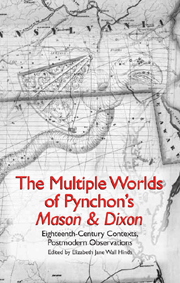 The Multiple Worlds of Pynchon's 'Mason and Dixon'
The Multiple Worlds of Pynchon's 'Mason and Dixon' Book contents
- Frontmatter
- Contents
- Preface
- Note on Quotations from Mason & Dixon
- The Rounds of History
- Introduction: The Times of Mason & Dixon
- 1 “The Space that may not be seen”: The Form of Historicity in Mason & Dixon
- Consumption Then and Now
- Space and Power
- Enlightenment Microhistories
- Works Cited
- Notes on the Contributors
- Index
Introduction: The Times of Mason & Dixon
from The Rounds of History
Published online by Cambridge University Press: 12 September 2012
- Frontmatter
- Contents
- Preface
- Note on Quotations from Mason & Dixon
- The Rounds of History
- Introduction: The Times of Mason & Dixon
- 1 “The Space that may not be seen”: The Form of Historicity in Mason & Dixon
- Consumption Then and Now
- Space and Power
- Enlightenment Microhistories
- Works Cited
- Notes on the Contributors
- Index
Summary
Happy are those ages when the starry sky is the map of all possible paths — ages whose paths are illuminated by the light of the stars. Everything in such ages is new and yet familiar, full of adventure and yet their own. The world is wide and yet it is like home, for the fire that burns in the soul is of the same essential nature as the stars.
— György Lukács, The Theory of the NovelMaking the Rounds of History
THOMAS PYNCHON'S 1997 Mason & Dixon is a novel obsessed with time. A “postmodern” novel, it reconstructs a historical period, the mid- to late-eighteenth century, with both an accuracy surpassing many bona fide histories and a disregard for the actual past seldom met with in a historical novel. Its play of and with histories, along with its determinedly late-twentieth-century timbre, makes time — and especially its passing — a constant focus. From first to last, from character Charles Mason's melancholia associated with his wife's passing, to the deep and broad concern with calendar reform in the novel, to the very fact of its being an “eighteenth-century” novel, Mason & Dixon layers time periods and temporal themes to produce an uncertainty of reading bordering on vertigo; finally, and from the first page, this constant thrust of time passing sets up a nostalgia that progresses and deepens at the same time the novel mocks the ludicrous idea of nostalgic sentimentality.
- Type
- Chapter
- Information
- The Multiple Worlds of Pynchon's 'Mason and Dixon'Eighteenth-Century Contexts, Postmodern Observations, pp. 3 - 24Publisher: Boydell & BrewerPrint publication year: 2005


